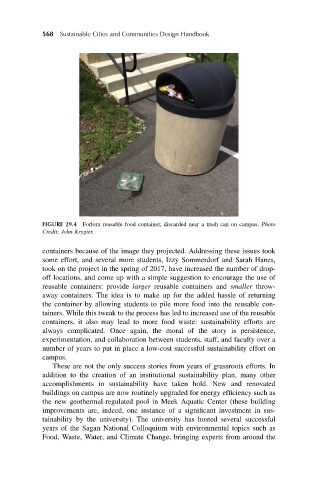Page 601 - Sustainable Cities and Communities Design Handbook
P. 601
568 Sustainable Cities and Communities Design Handbook
FIGURE 29.4 Forlorn reusable food container, discarded near a trash can on campus. Photo
Credit: John Krygier.
containers because of the image they projected. Addressing these issues took
some effort, and several more students, Izzy Sommerdorf and Sarah Hanes,
took on the project in the spring of 2017, have increased the number of drop-
off locations, and come up with a simple suggestion to encourage the use of
reusable containers: provide larger reusable containers and smaller throw-
away containers. The idea is to make up for the added hassle of returning
the container by allowing students to pile more food into the reusable con-
tainers. While this tweak to the process has led to increased use of the reusable
containers, it also may lead to more food waste: sustainability efforts are
always complicated. Once again, the moral of the story is persistence,
experimentation, and collaboration between students, staff, and faculty over a
number of years to put in place a low-cost successful sustainability effort on
campus.
These are not the only success stories from years of grassroots efforts. In
addition to the creation of an institutional sustainability plan, many other
accomplishments in sustainability have taken hold. New and renovated
buildings on campus are now routinely upgraded for energy efficiency such as
the new geothermal-regulated pool in Meek Aquatic Center (these building
improvements are, indeed, one instance of a significant investment in sus-
tainability by the university). The university has hosted several successful
years of the Sagan National Colloquium with environmental topics such as
Food, Waste, Water, and Climate Change, bringing experts from around the

